Dressing room on:
[Wikipedia]
[Google]
[Amazon]
A changing-room, locker-room, (usually in a sports, theater, or staff context) or changeroom (regional use) is a room or area designated for changing one's clothes. Changing-rooms are provided in a semi-public situation to enable people to change clothes with varying degrees of privacy.
 A fitting room, or dressing room, is a room where people try on clothes, such as in a department store.
Separate changing-rooms may be provided for men and women, or there may be a non-gender-specific open space with individual cubicles or stalls, as with
A fitting room, or dressing room, is a room where people try on clothes, such as in a department store.
Separate changing-rooms may be provided for men and women, or there may be a non-gender-specific open space with individual cubicles or stalls, as with 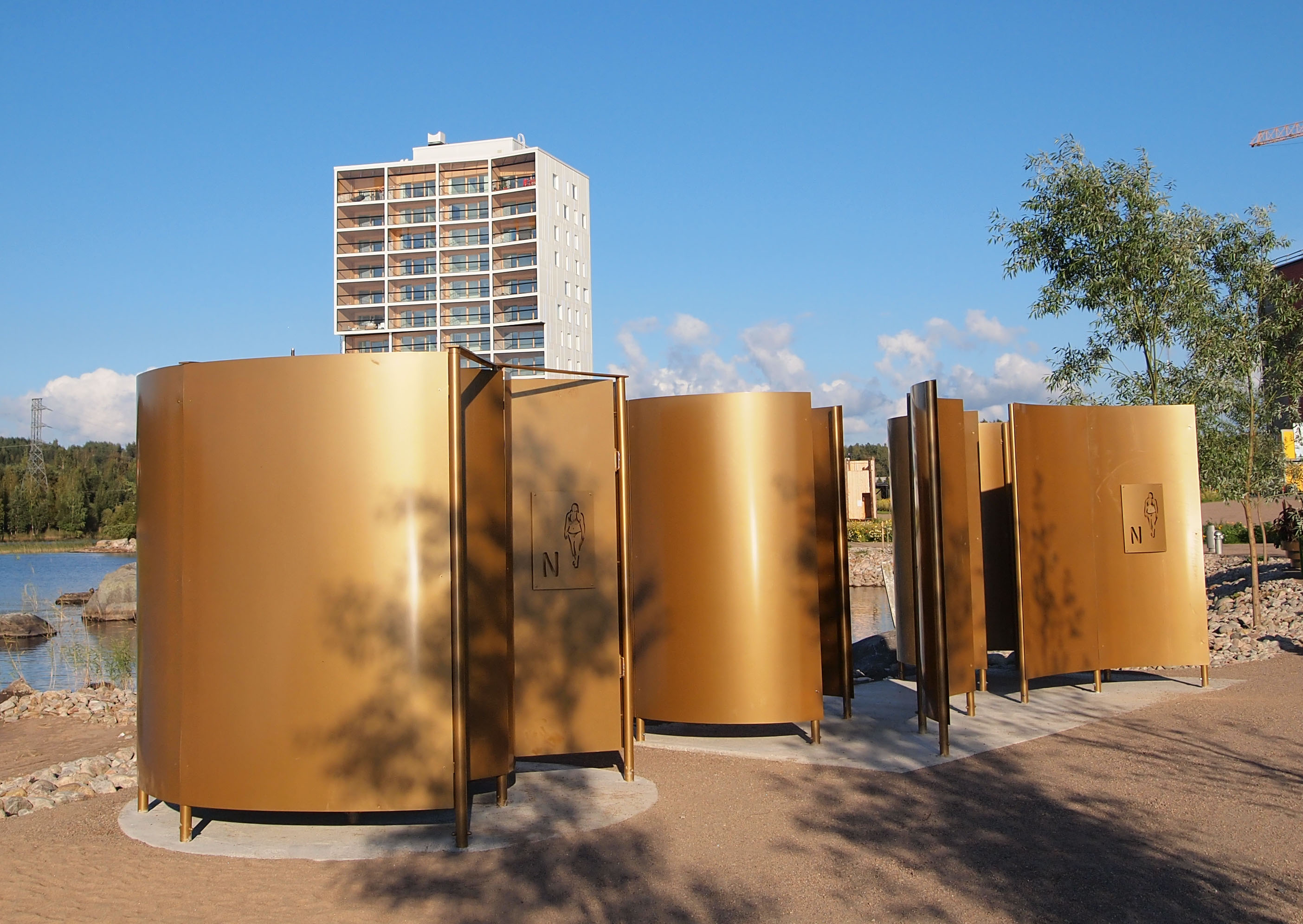 Larger changing rooms are usually found at public beaches, or other bathing areas, where most of the space is for changing, and minimal washroom space is included. Beach-style changing rooms are often large open rooms with benches against the walls. Some do not have a roof, providing just the barrier necessary to prevent people outside from seeing in.
Larger changing rooms are usually found at public beaches, or other bathing areas, where most of the space is for changing, and minimal washroom space is included. Beach-style changing rooms are often large open rooms with benches against the walls. Some do not have a roof, providing just the barrier necessary to prevent people outside from seeing in.
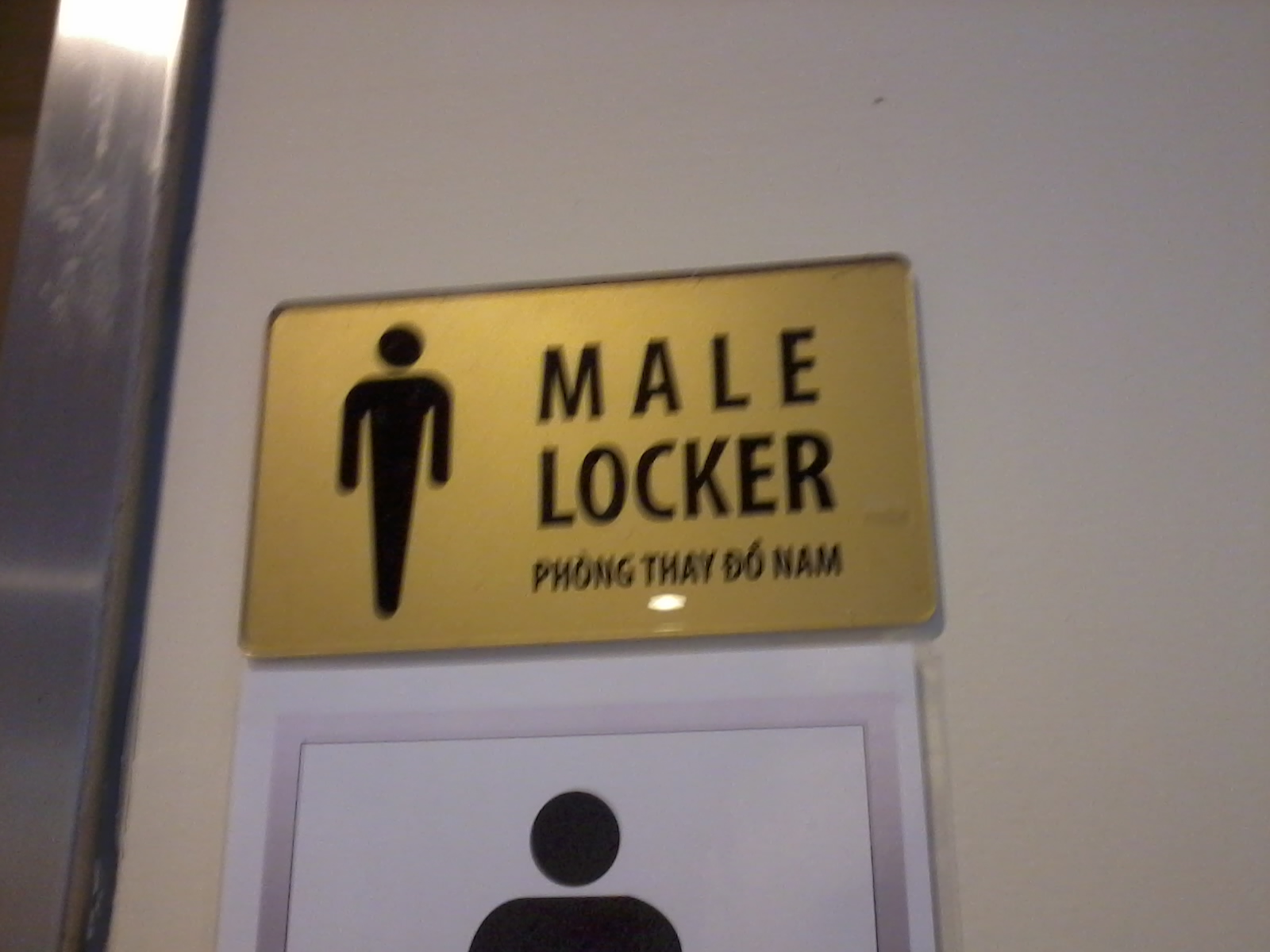
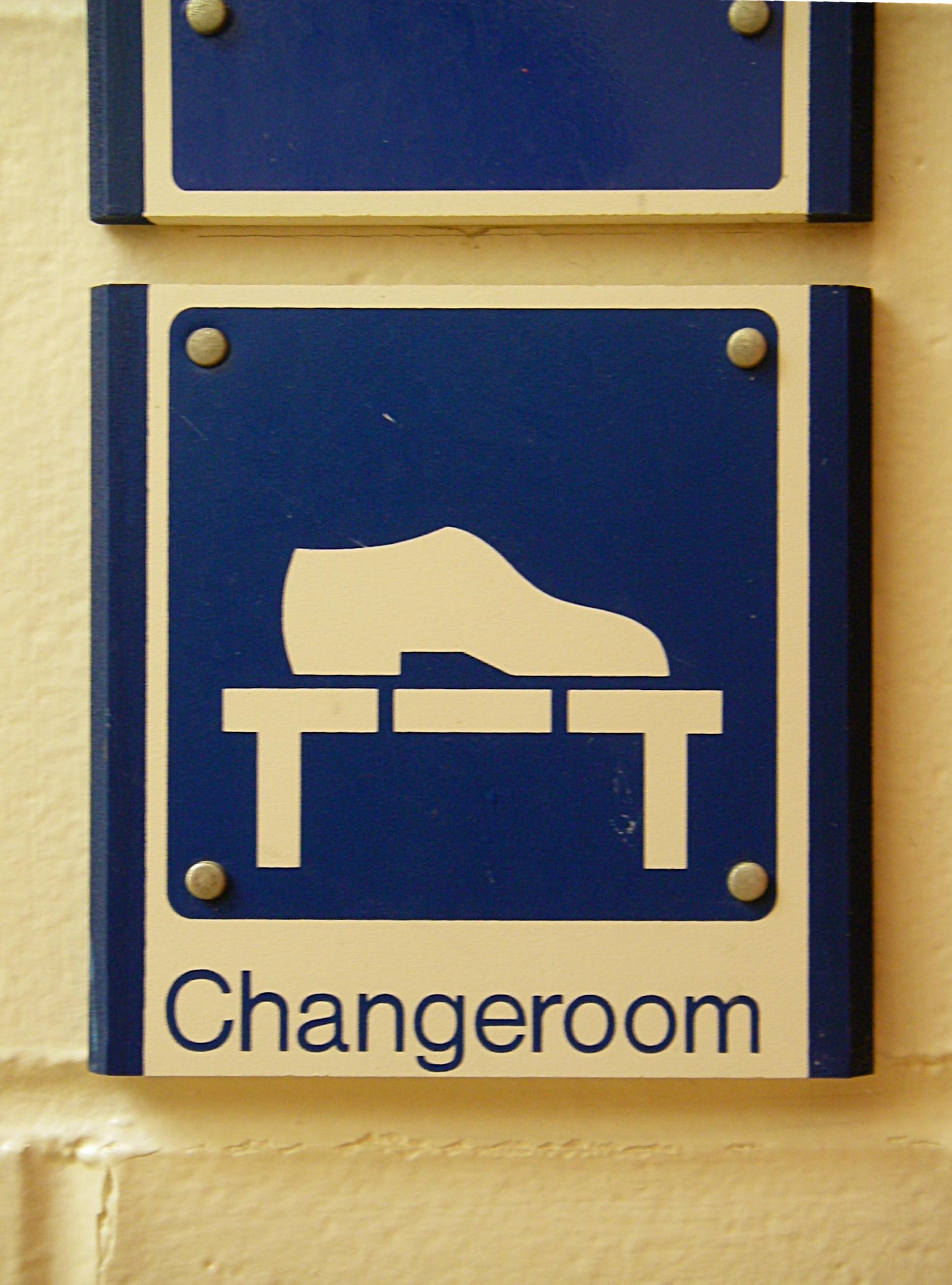 Various types of changing rooms exist:
* Changing-stalls are small stalls where clothes can be changed in privacy. They are used for any physical activity.
* Locker-rooms are usually gender-specific spaces where clothes are changed and stored in
Various types of changing rooms exist:
* Changing-stalls are small stalls where clothes can be changed in privacy. They are used for any physical activity.
* Locker-rooms are usually gender-specific spaces where clothes are changed and stored in
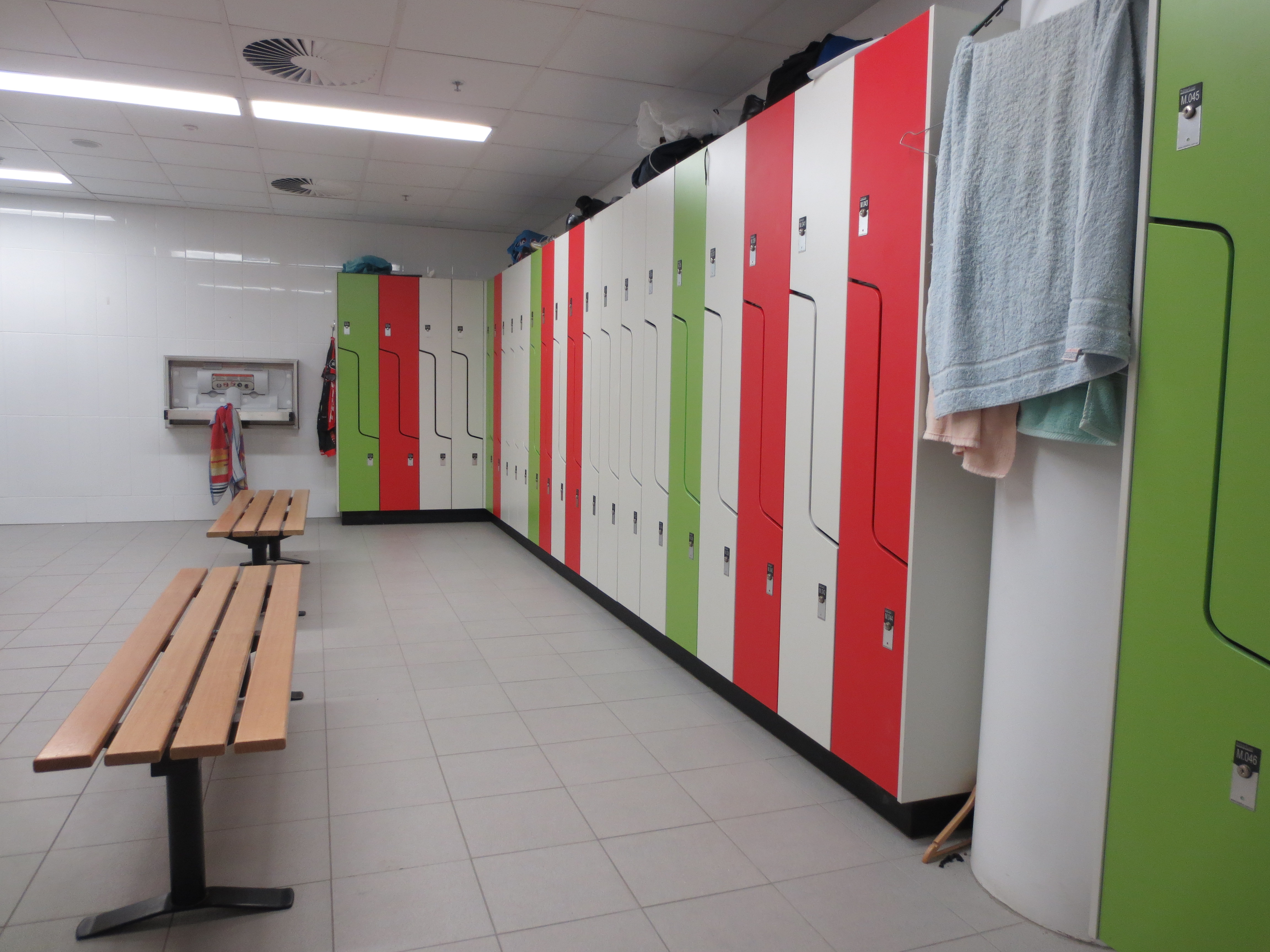 Locker rooms are thus named because they provide lockers for the storage of one's belongings. Alternatively, they may have a locker room attendant who will keep a person's belongings until one comes to retrieve them. Locker rooms are usually open spaces where people change together, but there are separate areas, or separate locker rooms, for men and women. Sometimes they are used in swimming complexes.
Locking devices used in locker rooms have traditionally been key or coin lockers, or lockers that are secured with a
Locker rooms are thus named because they provide lockers for the storage of one's belongings. Alternatively, they may have a locker room attendant who will keep a person's belongings until one comes to retrieve them. Locker rooms are usually open spaces where people change together, but there are separate areas, or separate locker rooms, for men and women. Sometimes they are used in swimming complexes.
Locking devices used in locker rooms have traditionally been key or coin lockers, or lockers that are secured with a
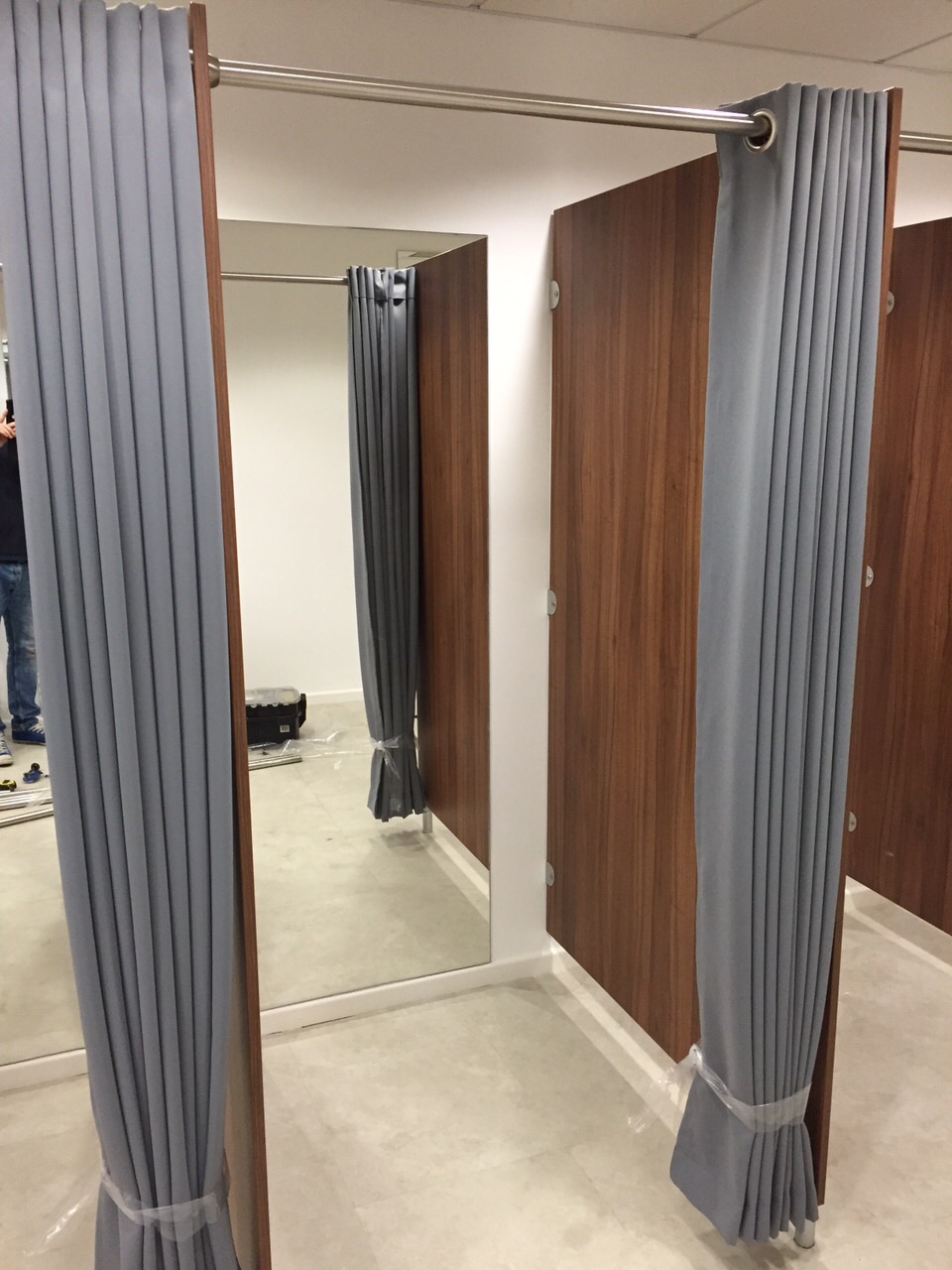 Fitting-rooms, or "dressing-rooms", are rooms where people try on clothes, such as in a department store. The rooms are usually individual rooms in which a person tries on clothes to determine fit before making a purchase. People do not always use the fitting rooms to change, as to change implies to remove one set of clothes and put on another. Sometimes a person chooses to try on clothes over their clothes (such as
Fitting-rooms, or "dressing-rooms", are rooms where people try on clothes, such as in a department store. The rooms are usually individual rooms in which a person tries on clothes to determine fit before making a purchase. People do not always use the fitting rooms to change, as to change implies to remove one set of clothes and put on another. Sometimes a person chooses to try on clothes over their clothes (such as
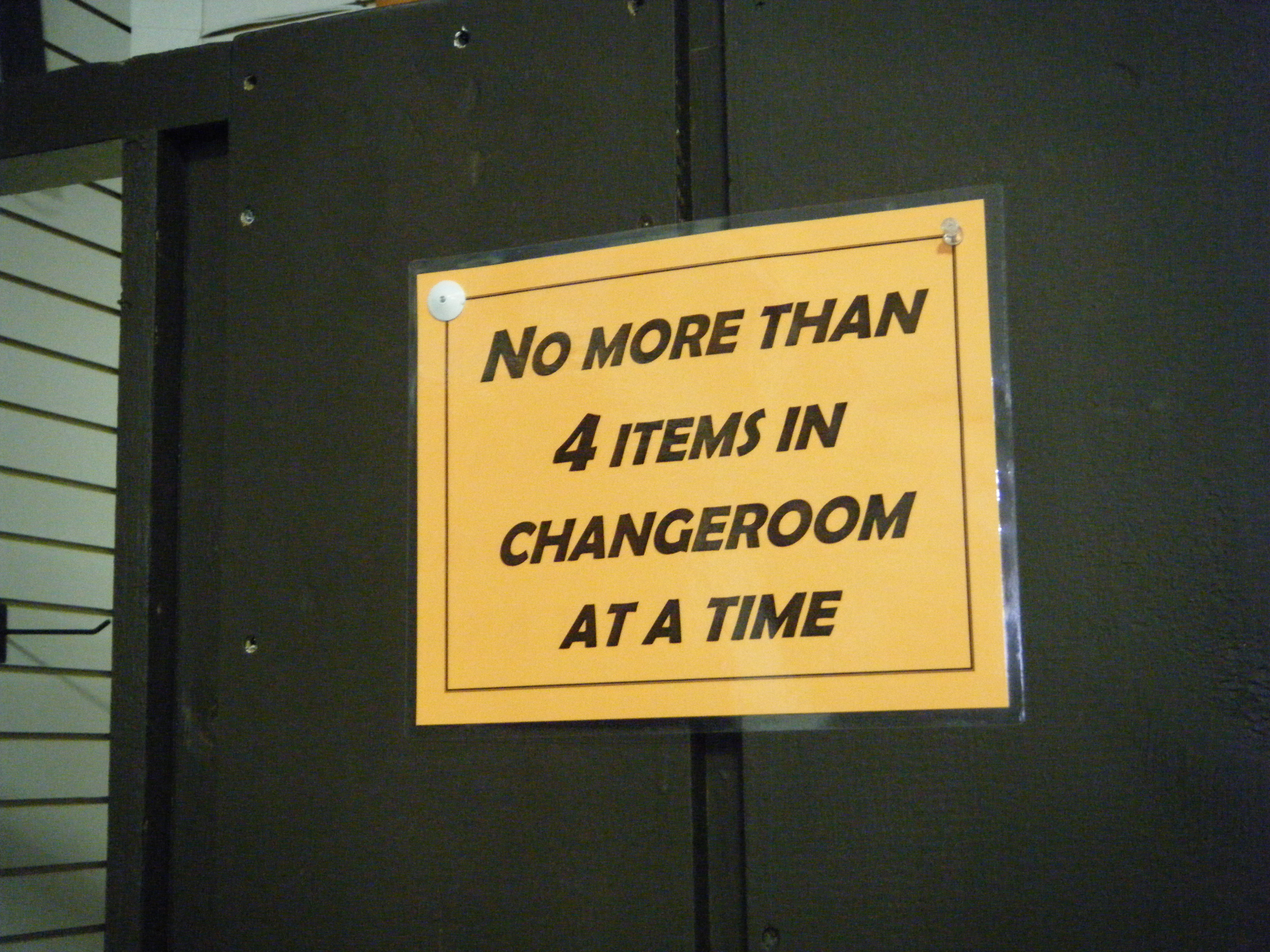 Retail establishments often post rules such as maximum number of items allowed in changing room, e.g. "no more than 4 items allowed in changing room".
Retail establishments often post rules such as maximum number of items allowed in changing room, e.g. "no more than 4 items allowed in changing room".
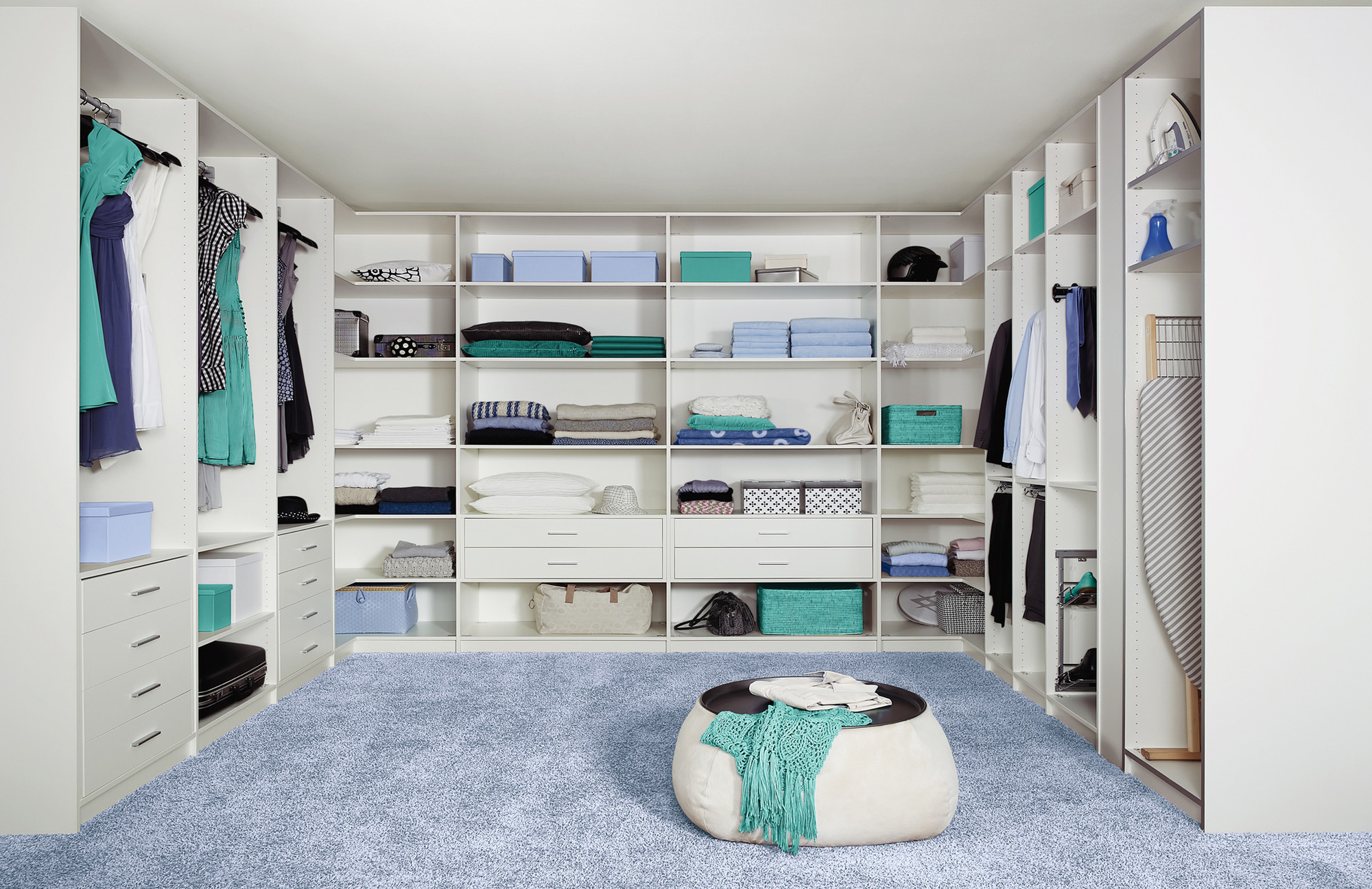 In larger Victorian houses it was common to have a private room called a ''
In larger Victorian houses it was common to have a private room called a ''
 A fitting room, or dressing room, is a room where people try on clothes, such as in a department store.
Separate changing-rooms may be provided for men and women, or there may be a non-gender-specific open space with individual cubicles or stalls, as with
A fitting room, or dressing room, is a room where people try on clothes, such as in a department store.
Separate changing-rooms may be provided for men and women, or there may be a non-gender-specific open space with individual cubicles or stalls, as with unisex public toilet
Unisex public toilets (also referred to as gender-inclusive, gender-neutral, mixed-sex or all-gender, or without any prefix at all) are public toilets that are not separated by gender or sex.
Unisex public toilets take different forms. They m ...
s. Many changing rooms include toilets, sinks and showers. Sometimes a changing room exists as a small portion of a restroom/washroom. For example, the men's and women's washrooms in Toronto's Dundas Square Dundas may refer to:
Places
Australia
* Dundas, New South Wales
* Dundas, Queensland, a locality in the Somerset Region
* Dundas, Tasmania
* Dundas, Western Australia
* Fort Dundas, a settlement in the Northern Territory 1824–1828
* Shire o ...
(which includes a water play area) each include a change area which is a blank counter space at the end of a row of sinks. In this case, the facility is primarily a washroom, and its use as a changing room is minimal, since only a small percentage of users change into bathing suit
A swimsuit is an item of clothing designed to be worn by people engaging in a water-based activity or water sports, such as swimming, diving and surfing, or sun-orientated activities, such as sun bathing. Different types may be worn by men, wom ...
s. Sometimes a person may change their clothes in a toilet cubicle of a washroom.
 Larger changing rooms are usually found at public beaches, or other bathing areas, where most of the space is for changing, and minimal washroom space is included. Beach-style changing rooms are often large open rooms with benches against the walls. Some do not have a roof, providing just the barrier necessary to prevent people outside from seeing in.
Larger changing rooms are usually found at public beaches, or other bathing areas, where most of the space is for changing, and minimal washroom space is included. Beach-style changing rooms are often large open rooms with benches against the walls. Some do not have a roof, providing just the barrier necessary to prevent people outside from seeing in.
Types

 Various types of changing rooms exist:
* Changing-stalls are small stalls where clothes can be changed in privacy. They are used for any physical activity.
* Locker-rooms are usually gender-specific spaces where clothes are changed and stored in
Various types of changing rooms exist:
* Changing-stalls are small stalls where clothes can be changed in privacy. They are used for any physical activity.
* Locker-rooms are usually gender-specific spaces where clothes are changed and stored in locker
A locker is a small, usually narrow storage compartment. They are commonly found in dedicated cabinets, very often in large numbers, in various public places such as locker rooms, workplaces, elementary schools, middle and high schools, tran ...
s. They are often used for swimming or other sporting-purposes. They are open spaces with no stalls. These rooms include toilets, sinks, and showers.
* Fitting-rooms, or dressing-rooms, are usually small single-user-cubicles where a person may try on clothes. These are often found at retail-stores where one would want to try on clothes before purchasing them.
Changing-stalls
Changing-stalls are small stalls where clothes can be changed in privacy. Clothes are usually stored inlocker
A locker is a small, usually narrow storage compartment. They are commonly found in dedicated cabinets, very often in large numbers, in various public places such as locker rooms, workplaces, elementary schools, middle and high schools, tran ...
s. There are usually no separate areas for men and women. They are often combined with gender-separated communal showers. Most public pools have changing-facilities of this kind alongside communal changing-rooms. Some other places also offer these changing stalls such as fitness centers.
Communal changing-rooms
combination lock
A combination lock is a type of locking device in which a sequence of symbols, usually numbers, is used to open the lock. The sequence may be entered using a single rotating dial which interacts with several discs or ''cams'', by using a set o ...
. Newer locker rooms may be automated, with robotic machines to store clothes, with such features as a fingerprint scanner to enroll and for later retrieval. Locker rooms in some water parks use a microchip equipped wristband. The same wristband that unlocks the lockers can be used to purchase food and drinks and other items in the water park.
Some communal changing rooms are only supposed to be used by groups of persons, not individuals. In this case, there may be no lockers. Instead, the entire room is locked in order to protect belongings from theft.
Locker-rooms are also used in many middle schools and high schools. Most of them include showers for after Physical Education.
At an outdoor sports facility, the changing rooms may be integrated into a pavilion
In architecture, ''pavilion'' has several meanings:
* It may be a subsidiary building that is either positioned separately or as an attachment to a main building. Often it is associated with pleasure. In palaces and traditional mansions of Asia ...
or clubhouse, with other facilities such as seating or a bar.
(Store-)fitting-rooms
 Fitting-rooms, or "dressing-rooms", are rooms where people try on clothes, such as in a department store. The rooms are usually individual rooms in which a person tries on clothes to determine fit before making a purchase. People do not always use the fitting rooms to change, as to change implies to remove one set of clothes and put on another. Sometimes a person chooses to try on clothes over their clothes (such as
Fitting-rooms, or "dressing-rooms", are rooms where people try on clothes, such as in a department store. The rooms are usually individual rooms in which a person tries on clothes to determine fit before making a purchase. People do not always use the fitting rooms to change, as to change implies to remove one set of clothes and put on another. Sometimes a person chooses to try on clothes over their clothes (such as sweater
A sweater (North American English) or pullover, also called a jumper (British English and Australian English), ...
s or coats), but would still like to do this in private. Thus fitting rooms may be used for changing, or just for fitting without changing.
Rules and conventions
History
It appears that the first store fitting rooms appeared with the spread of department stores.« ''Essayer en corps. Sociologie des cabines d'essayage'' », Thierry Caro, mémoire de fin d'études à l' Institut d'études politiques de Lille, 2004.Émile Zola
Émile Édouard Charles Antoine Zola (, also , ; 2 April 184029 September 1902) was a French novelist, journalist, playwright, the best-known practitioner of the literary school of naturalism, and an important contributor to the development of ...
noted their existence in his novel ''Au Bonheur des Dames
''Au Bonheur des Dames'' (; ''The Ladies' Delight'' or ''The Ladies' Paradise'') is the eleventh novel in the '' Rougon-Macquart'' series by Émile Zola. It was first serialized in the periodical '' Gil Blas'' from December 17, 1882 to March 1, 18 ...
'' (1883), and that they were then forbidden to men. Some years later, when Henri Gervex
Henri Gervex (Paris 10 December 1852 – 7 June 1929 Paris) was a French painter who studied painting under Alexandre Cabanel, Pierre-Nicolas Brisset, and Eugène Fromentin.
Biography Early years
He was the son of Joséphine Peltier and Félix ...
, who painted Jeanne Paquin
Jeanne Paquin () (1869–1936) was a leading French fashion designer, known for her resolutely modern and innovative designs. She was the first major female couturier and one of the pioneers of the modern fashion business.
Early life
Jeanne P ...
in 1906, that was no longer the case.
In any case, Buster Keaton worked in one in an American 1928 silent comedy ''The Cameraman
''The Cameraman'' is a 1928 American silent romantic comedy film directed by Edward Sedgwick and an uncredited Buster Keaton. The picture stars Keaton and Marceline Day.
''The Cameraman'' was Keaton's first film with Metro-Goldwyn-Mayer. It ...
''. Since then, they have continued to provide comic scenes in films, for example in the 1995 French film ''Les Trois Frères
''The Three Brothers'' (french: Les Trois Frères) is a 1995 French comedy film written, directed by and starring Didier Bourdon and Bernard Campan alongside their Les Inconnus partner Pascal Légitimus.
The film won the award for Best Debut ...
''.
Dressing-rooms (domestic)
 In larger Victorian houses it was common to have a private room called a ''
In larger Victorian houses it was common to have a private room called a ''boudoir
A boudoir (; ) is a woman's private sitting room or salon in a furnished residence, usually between the dining room and the bedroom, but can also refer to a woman's private bedroom. The term derives from the French verb ''bouder'' (to sulk ...
'' for the lady of the house that is accessible from the bedroom, and also a dressing room for the gentleman (and sometimes a man's cabinet).
Security
Because of the privacy afforded by changing rooms, they create a problem in the trade off between security and privacy, where in it may be possible for crime to be perpetrated by people using the cover of privacy to sell drugs, or steal clothing from a department store. Some department stores have security cameras in the changing rooms. Communal changing-rooms pose less of a risk of theft than fitting-rooms, because there is not total privacy. In particular, the perpetrator of a crime would not know whether or not other users might be undercover police or security guards. Many modern changing rooms often havelabyrinth
In Greek mythology, the Labyrinth (, ) was an elaborate, confusing structure designed and built by the legendary artificer Daedalus for King Minos of Crete at Knossos. Its function was to hold the Minotaur, the monster eventually killed by t ...
-style entrances that have no door, so that people outside cannot see in, but security can walk in at any time without the sound of an opening door alerting persons inside. Washrooms in which changing clothes is merely a secondary purpose often also have such labyrinth openings. Many washrooms have security cameras in the main area with a view of the sinks and the urinals from a viewing angle that would only show the back of a user. However, when a washroom is located near a fountain, wading pool, or the like, and is likely to be used for changing clothes, some believe that washroom surveillance cameras would be a violation of privacy.
Another security risk present is that of theft. Sometimes no method of securing items is provided, but even lockable lockers or baskets are usually designed for only minimal security allowing experienced thieves to steal the valuable items which people typically have with them before changing. Changing room operators frequently post signs disclaiming responsibility for stolen items, which can discourage but not eliminate claims for negligence.
See also
* Virtual dressing roomReferences
External links
* {{DEFAULTSORT:Changing Room Rooms Bathing Sex segregation